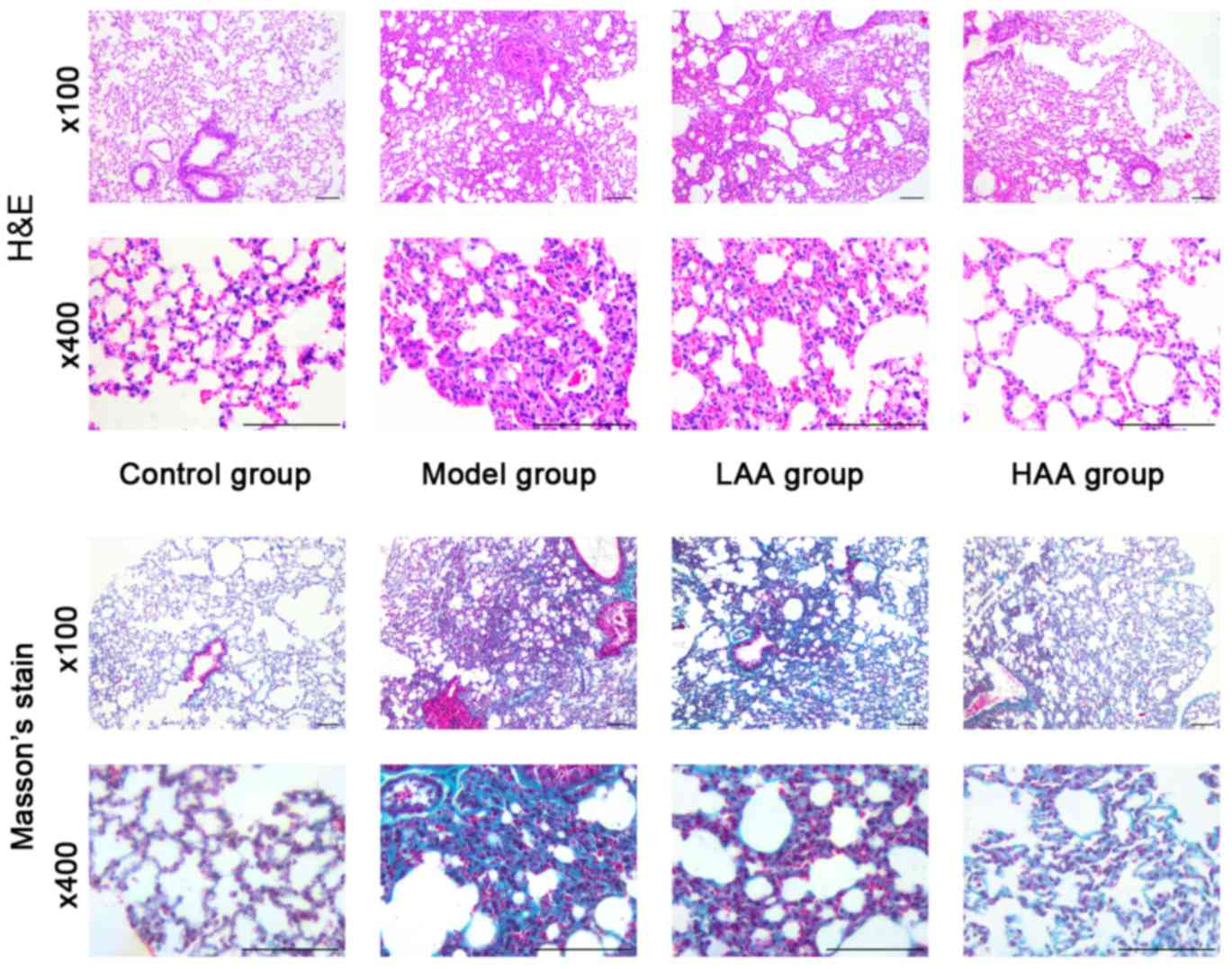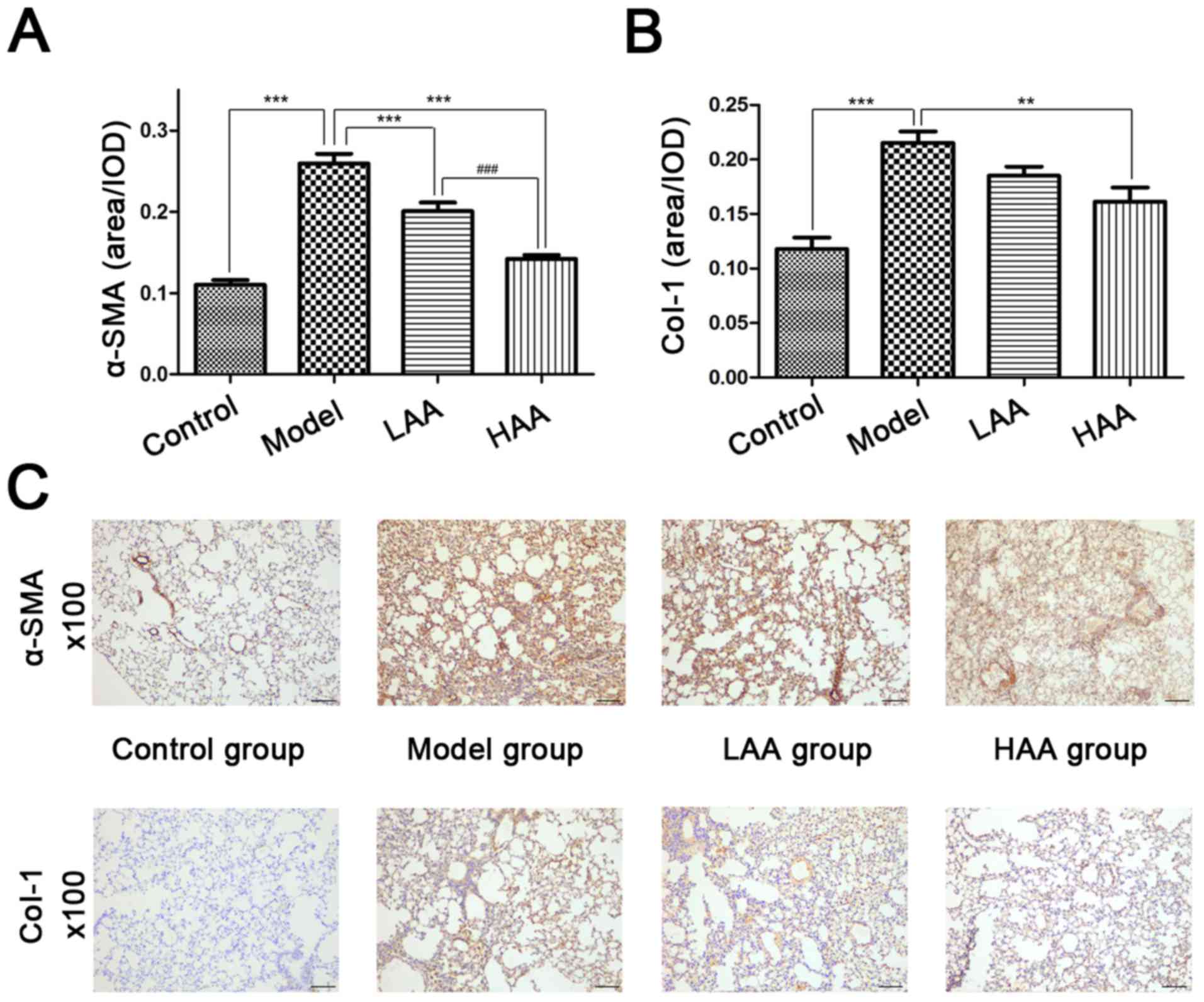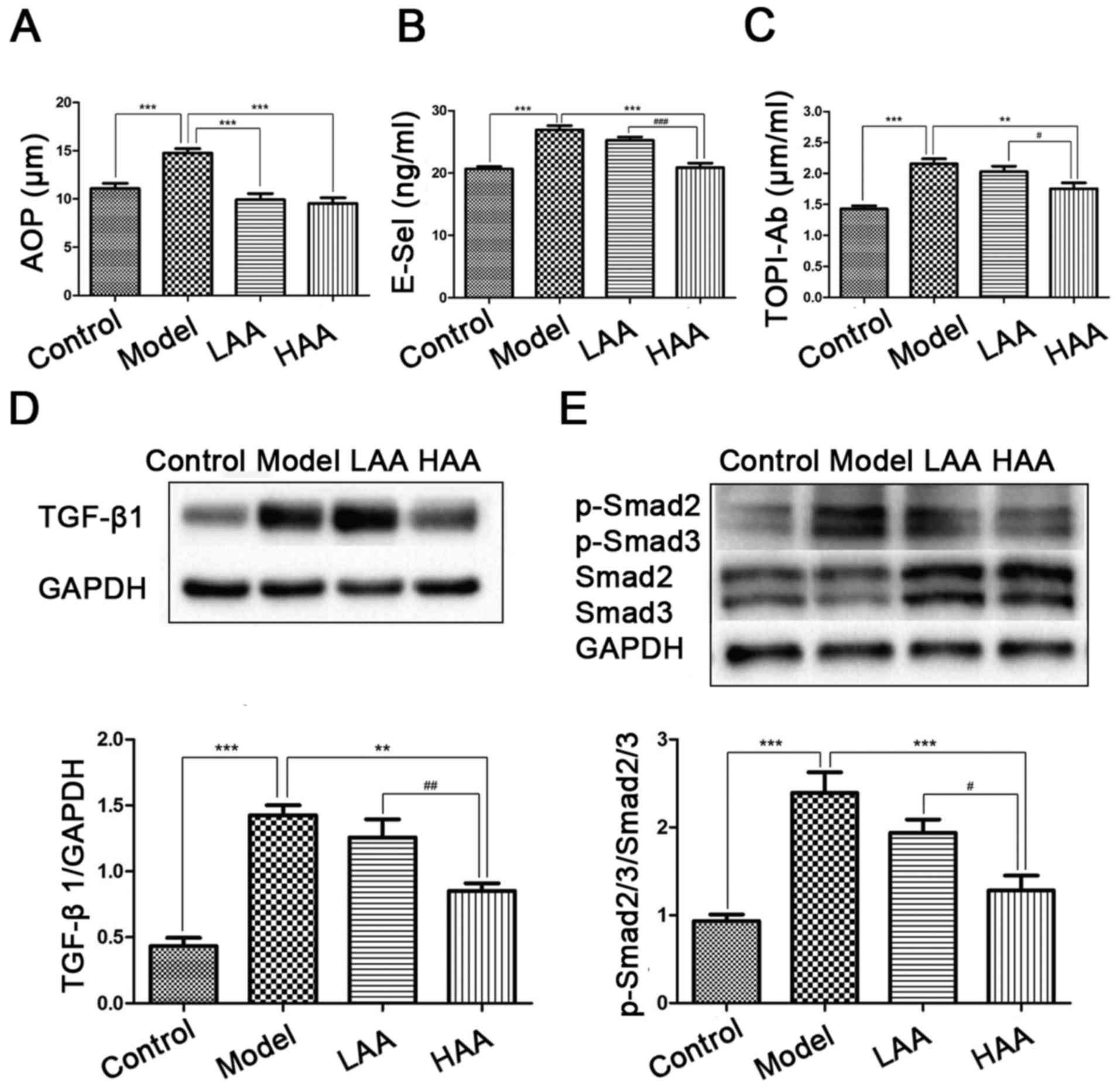|
1
|
Balbir-Gurman A and Braun-Moscovici Y:
Scleroderma-new aspects in pathogenesis and treatment. Best Prac
Res Clin Rheumatol. 26:13–24. 2012. View Article : Google Scholar
|
|
2
|
Tyndall AJ, Bannert B, Vonk M, Airò P,
Cozzi F, Carreira PE, Bancel DF, Allanore Y, Müller-Ladner U,
Distler O, et al: Causes and risk factors for death in systemic
sclerosis: A study from the EULAR Scleroderma Trials and Research
(EUSTAR) database. Ann Rheum Dis. 69:1809–1815. 2010. View Article : Google Scholar : PubMed/NCBI
|
|
3
|
Bourji K, Meyer A, Chatelus E, Pincemail
J, Pigatto E, Defraigne JO, Singh F, Charlier C, Geny B, Gottenberg
JE, et al: High reactive oxygen species in fibrotic and nonfibrotic
skin of patients with diffuse cutaneous systemic sclerosis. Free
Radic Biol Med. 87:282–289. 2015. View Article : Google Scholar : PubMed/NCBI
|
|
4
|
Yoshizaki A, Iwata Y, Komura K, Ogawa F,
Hara T, Muroi E, Takenaka M, Shimizu K, Hasegawa M, Fujimoto M, et
al: CD19 regulates skin and lung fibrosis via Toll-like receptor
signaling in a model of bleomycin-induced scleroderma. Am J Pathol.
172:1650–1663. 2008. View Article : Google Scholar : PubMed/NCBI
|
|
5
|
Allanore Y, Borderie D, Lemarechal H,
Ekindjian OG and Kahan A: Acute and sustained effects of
dihydropyridine-type calcium channel antagonists on oxidative
stress in systemic sclerosis. Am J Med. 116:595–600. 2004.
View Article : Google Scholar : PubMed/NCBI
|
|
6
|
Sambo P, Baroni SS, Luchetti M, Paroncini
P, Dusi S, Orlandini G and Gabrielli A: Oxidative stress in
scleroderma: Maintenance of scleroderma fibroblast phenotype by the
constitutive up-regulation of reactive oxygen species generation
through the NADPH oxidase complex pathway. Arthritis Rheum.
44:2653–2664. 2001. View Article : Google Scholar : PubMed/NCBI
|
|
7
|
Varga J and Abraham D: Systemic sclerosis:
A prototypic multisystem fibrotic disorder. J Clin Invest.
117:557–567. 2007. View
Article : Google Scholar : PubMed/NCBI
|
|
8
|
Fernandez IE and Eickelberg O: The impact
of TGF-β on lung fibrosis: From targeting to biomarkers. Proc Am
Thorac Soc. 9:111–116. 2012. View Article : Google Scholar : PubMed/NCBI
|
|
9
|
Liu RM and Desai LP: Reciprocal regulation
of TGF-β and reactive oxygen species: A perverse cycle for
fibrosis. Redox Biol. 6:565–577. 2015. View Article : Google Scholar : PubMed/NCBI
|
|
10
|
Pociask DA, Sime PJ and Brody AR:
Asbestos-derived reactive oxygen species activate TGF-beta1. Lab
Invest. 84:1013–1023. 2004. View Article : Google Scholar : PubMed/NCBI
|
|
11
|
Xu L, Cui WH, Zhou WC, Li DL, Li LC, Zhao
P, Mo XT, Zhang Z and Gao J: Activation of Wnt/beta-catenin
signalling is required for TGF-β/Smad2/3 signalling during
myofibroblast proliferation. J Cell Mol Med. 21:1545–1554. 2017.
View Article : Google Scholar : PubMed/NCBI
|
|
12
|
Bian D, Zhang J, Wu X, Dou Y, Yang Y, Tan
Q, Xia Y, Gong Z and Dai Y: Asiatic acid isolated from Centella
asiatica inhibits TGF-β1-induced collagen expression in human
keloid fibroblasts via PPAR-gamma activation. Int J Biol Sci.
9:1032–1042. 2013. View Article : Google Scholar : PubMed/NCBI
|
|
13
|
Meng XM, Zhang Y, Huang XR, Ren GL, Li J
and Lan HY: Treatment of renal fibrosis by rebalancing TGF-β/Smad
signaling with the combination of asiatic acid and naringenin.
Oncotarget. 6:36984–36997. 2015. View Article : Google Scholar : PubMed/NCBI
|
|
14
|
Si L, Xu J, Yi C, Xu X, Ma C, Yang J, Wang
F, Zhang Y and Wang X: Asiatic acid attenuates the progression of
left ventricular hypertrophy and heart failure induced by pressure
overload by inhibiting myocardial remodeling in mice. J Cardiovasc
Pharmacol. 66:558–568. 2015. View Article : Google Scholar : PubMed/NCBI
|
|
15
|
Xu X, Si L, Xu J, Yi C, Wang F, Gu W,
Zhang Y and Wang X: Asiatic acid inhibits cardiac hypertrophy by
blocking interleukin-1β-activated nuclear factor-κB signaling in
vitro and in vivo. J Thorac Dis. 7:1787–1797. 2015.PubMed/NCBI
|
|
16
|
Xu C, Wang W, Xu M and Zhang J: Asiatic
acid ameliorates tubulointerstitial fibrosis in mice with ureteral
obstruction. Exp Ther Med. 6:731–736. 2013. View Article : Google Scholar : PubMed/NCBI
|
|
17
|
Ramachandran V and Saravanan R: Efficacy
of asiatic acid, a pentacyclic triterpene on attenuating the key
enzymes activities of carbohydrate metabolism in
streptozotocin-induced diabetic rats. Phytomedicine. 20:230–236.
2013. View Article : Google Scholar : PubMed/NCBI
|
|
18
|
Barnes J and Mayes MD: Epidemiology of
systemic sclerosis: Incidence, prevalence, survival, risk factors,
malignancy, and environmental triggers. Curr Opin Rheumatol.
24:165–170. 2012. View Article : Google Scholar : PubMed/NCBI
|
|
19
|
Highland KB and Silver RM: New
developments in scleroderma interstitial lung disease. Curr Opin
Rheumatol. 17:737–745. 2005. View Article : Google Scholar : PubMed/NCBI
|
|
20
|
Tang LX, He RH, Yang G, Tan JJ, Zhou L,
Meng XM, Huang XR and Lan HY: Asiatic acid inhibits liver fibrosis
by blocking TGF-beta/Smad signaling in vivo and in vitro. PLoS One.
7:e313502012. View Article : Google Scholar : PubMed/NCBI
|
|
21
|
Dong SH, Liu YW, Wei F, Tan HZ and Han ZD:
Asiatic acid ameliorates pulmonary fibrosis induced by bleomycin
(BLM) via suppressing pro-fibrotic and inflammatory signaling
pathways. Biomed Pharmacother. 89:1297–1309. 2017. View Article : Google Scholar : PubMed/NCBI
|
|
22
|
Asano Y, Ihn H, Yamane K, Kubo M and
Tamaki K: Impaired Smad7-Smurf-mediated negative regulation of
TGF-beta signaling in scleroderma fibroblasts. J Clin Invest.
113:253–264. 2004. View
Article : Google Scholar : PubMed/NCBI
|
|
23
|
Zhang H, Ran X, Hu CL, Qin LP, Lu Y and
Peng C: Therapeutic effects of liposome-enveloped ligusticum
chuanxiong essential oil on hypertrophic scars in the rabbit ear
model. PLoS One. 7:e311572012. View Article : Google Scholar : PubMed/NCBI
|
|
24
|
Bei Y, Hua-Huy T, Nicco C, Duong-Quy S,
Le-Dong NN, Tiev KP, Chéreau C, Batteux F and Dinh-Xuan AT:
RhoA/Rho-kinase activation promotes lung fibrosis in an animal
model of systemic sclerosis. Exp Lung Res. 42:44–45. 2016.
View Article : Google Scholar : PubMed/NCBI
|
|
25
|
Servettaz A, Goulvestre C, Kavian N, Nicco
C, Guilpain P, Chéreau C, Vuiblet V, Guillevin L, Mouthon L, Weill
B and Batteux F: Selective oxidation of DNA topoisomerase 1 induces
systemic sclerosis in the mouse. J Immunol. 182:5855–5864. 2009.
View Article : Google Scholar : PubMed/NCBI
|
|
26
|
Servettaz A, Guilpain P, Goulvestre C,
Chéreau C, Hercend C, Nicco C, Guillevin L, Weill B, Mouthon L and
Batteux F: Radical oxygen species production induced by advanced
oxidation protein products predicts clinical evolution and response
to treatment in systemic sclerosis. Ann Rheum Dis. 66:1202–1209.
2007. View Article : Google Scholar : PubMed/NCBI
|
|
27
|
Blackburn RM: Too much of a good thing:
Adenosine overload in adenosine-deaminase-deficient mice. Trends
Pharmacol Sci. 24:66–70. 2003. View Article : Google Scholar : PubMed/NCBI
|
|
28
|
Kim HJ, Tashkin DP, Gjertson DW, Brown MS,
Kleerup E, Chong S, Belperio JA, Roth MD, Abtin F, Elashoff R, et
al: Transitions to different patterns of interstitial lung disease
in scleroderma with and without treatment. Ann Rheum Dis.
75:1367–1371. 2016. View Article : Google Scholar : PubMed/NCBI
|
|
29
|
Adtani PN, Narasimhan M, Punnoose AM and
Kambalachenu HR: Antifibrotic effect of Centella asiatica
Linn and asiatic acid on arecoline-induced fibrosis in human buccal
fibroblasts. J Investig Clin Dent. 8:2017. View Article : Google Scholar : PubMed/NCBI
|
|
30
|
Liu J, He T, Lu Q, Shang J, Sun H and
Zhang L: Asiatic acid preserves beta cell mass and mitigates
hyperglycemia in streptozocin-induced diabetic rats. Diabetes Metab
Res Rev. 26:448–454. 2010. View Article : Google Scholar : PubMed/NCBI
|
|
31
|
Sato M, Hirayama S, Lara-Guerra H, Anraku
M, Waddell TK, Liu M and Keshavjee S: MMP-dependent migration of
extrapulmonary myofibroblast progenitors contributing to
posttransplant airway fibrosis in the lung. Am J Transplant.
9:1027–1036. 2009. View Article : Google Scholar : PubMed/NCBI
|
|
32
|
Wolters PJ, Collard HR and Jones KD:
Pathogenesis of idiopathic pulmonary fibrosis. Annu Rev Pathol.
9:157–179. 2014. View Article : Google Scholar : PubMed/NCBI
|
|
33
|
Su BH, Tseng YL, Shieh GS, Chen YC, Wu P,
Shiau AL and Wu CL: Over-expression of prothymosin-alpha
antagonizes TGFβ signalling to promote the development of
emphysema. J Pathol. 238:412–422. 2016. View Article : Google Scholar : PubMed/NCBI
|
|
34
|
Sato M, Muragaki Y, Saika S, Roberts AB
and Ooshima A: Targeted disruption of TGF-beta1/Smad3 signaling
protects against renal tubulointerstitial fibrosis induced by
unilateral ureteral obstruction. J Clin Invest. 112:1486–1494.
2003. View Article : Google Scholar : PubMed/NCBI
|
|
35
|
Wang P, Wang Y, Nie X, Braïni C, Bai R and
Chen C: Multiwall carbon nanotubes directly promote
fibroblast-myofibroblast and epithelial-mesenchymal transitions
through the activation of the TGF-β/Smad signaling pathway. Small.
11:446–455. 2015. View Article : Google Scholar : PubMed/NCBI
|
|
36
|
Yamane K, Ihn H, Kubo M, Yazawa N, Kikuchi
K, Soma Y and Tamaki K: Increased serum levels of soluble vascular
cell adhesion molecule 1 and E-selectin in patients with localized
scleroderma. J Am Acad Dermatol. 42:64–69. 2000. View Article : Google Scholar : PubMed/NCBI
|

















